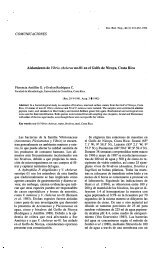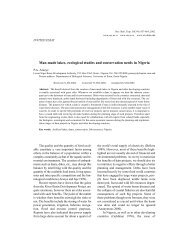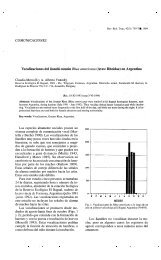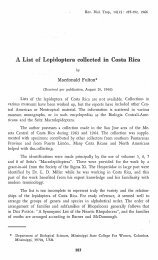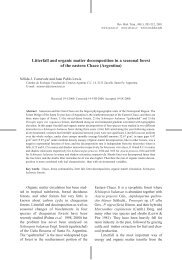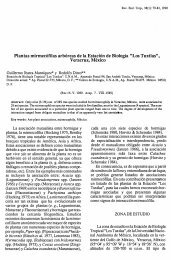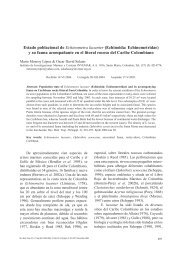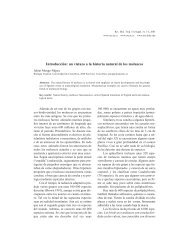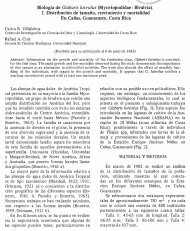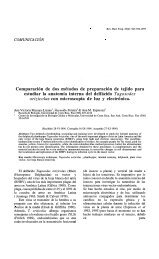Oswaldofilaria medemi n. sp. (Nematoda : Filarioidea) - Revista de ...
Oswaldofilaria medemi n. sp. (Nematoda : Filarioidea) - Revista de ...
Oswaldofilaria medemi n. sp. (Nematoda : Filarioidea) - Revista de ...
Create successful ePaper yourself
Turn your PDF publications into a flip-book with our unique Google optimized e-Paper software.
Rev. Biol. Trop., 29(1): 5-10, 1981<br />
<strong>Oswaldofilaria</strong> <strong>me<strong>de</strong>mi</strong> n. <strong>sp</strong>. (<strong>Nematoda</strong> : <strong>Filarioi<strong>de</strong>a</strong>),<br />
from the smooth-fronted caiman, Paleosuchus trigonatus<br />
from Colombia<br />
by<br />
C. J. Marinkelle *<br />
(Received for publication May 28, 1979)<br />
Abstract: A filaria! worm, <strong>Oswaldofilaria</strong> <strong>me<strong>de</strong>mi</strong> n. <strong>sp</strong>., obtained from the<br />
thoracic wall of an adult Colombian caiman, Paleosuchus trigonatus (Schnei<strong>de</strong>r,<br />
1801) is <strong>de</strong>scribed. The new filaria differs from all other <strong>sp</strong>ecies of the genus by<br />
the long oesophagus and by differences in size and shape of the <strong>sp</strong>iculae in the<br />
maleo Microfilariae could not be found in the blood of sixP. trigonatus.<br />
Few filarid-like worms are known from Crocodylidae. In Asia, Micropleura<br />
vivipara of the family Dracunculidae was <strong>de</strong>scribed from gaviales. In Brazil,M vazi<br />
was <strong>de</strong>scribed by Travassos (1933) from Caiman sclerops and <strong>Oswaldofilaria</strong><br />
bacillaris was found in Melanosuchus niger by Molin (1858) and in Caiman sclerops<br />
by Travassos (1933). A distinct <strong>sp</strong>ecies of <strong>Oswaldofilaria</strong> was recently obtained<br />
from Colombian Paleosuchus trigonatus crocodillians.<br />
<strong>Oswaldofilaria</strong> was separated from the genus Filaría by Travassos (1933)<br />
based on morphological differences in the buccal capsule, oesophagus, caudal<br />
extremity of worm, ovijector, <strong>sp</strong>icules, caudal papillae of male and position of the<br />
vulva.<br />
MATERIAL AND METHODS<br />
One intact male, three intact females and three slightly damaged females of a<br />
new <strong>sp</strong>e cie s of filaria were recovered from the thoracic wall of an adult<br />
smooth-fronted male caiman Paleosuchus trigonatus (Schnei<strong>de</strong>r, 1801). The<br />
recovered worms were washed in normal saline solution and preserved in 70%<br />
alcohol with 25% glycerol. Clearing was done in lactophenol. The cephalic<br />
structures of female paratypes were studied by the method <strong>de</strong>scribed by An<strong>de</strong>rson<br />
(1958). Measurements were ma<strong>de</strong> on preserved, cleared <strong>sp</strong>ecimens or on camera<br />
lucida drawings. The blood of the caiman was exarnined by Knott's (1939)<br />
concentration method but no rnicrofilariae were found. In the following <strong>de</strong>scription<br />
all measurements are in mm.<br />
* Departamento <strong>de</strong> Microbiología y Parasitología, Universidad <strong>de</strong> Cartagena, A. A. 1313,<br />
Cartagena Colombia. Present address: Laboratorio <strong>de</strong> Microbiología y Parasitología <strong>de</strong><br />
los An<strong>de</strong>s, Apdo. Aéreo 4976, Bogotá, Colombia.<br />
5
6 REVISTA DE BIOLOGIA TROPICAL<br />
RE SU LT S<br />
The worms found in Paleosuchus trigo na tus be long to the genus<br />
<strong>Oswaldofilaria</strong> Travassos, 1933. Because of certain characteristics, this new <strong>sp</strong>ecies<br />
has been named <strong>Oswaldofilaria</strong> <strong>me<strong>de</strong>mi</strong> n. <strong>sp</strong>., in honour of Dr. F. Me<strong>de</strong>m, who for<br />
the frrst time collected P. trigonatus in Colombia.<br />
Description: The <strong>sp</strong>ecimens collected from the Colombian caimans showed<br />
the following characteristics: body cuticle with fme striationsj stoma simple with a<br />
small but distinct buccal capsule; oesophagus long and clearly divi<strong>de</strong>d into an<br />
anterior short muscular part, and long broad glandular posterior part (Fig. 1); head<br />
blunt; caudal extremity digitiform in both sexes; lateral alae absent. Females are<br />
opisto<strong>de</strong>lphic and viviparous: ovijector long; vulva placed a short distance behind<br />
termination of glandular oesophagus. Male with caudal papillae and <strong>sp</strong>icules<br />
dissirnilar and unequal.<br />
Male: Measurements are given in the Table 1. The cuticle consists of three<br />
layers; outer layer with transverse fine striations, medial layer without striations,<br />
and smooth inner layer with fine longitudinal striations. Cephalic papillae similar to<br />
those of the female. The nerve ring is clearly visible (Fig. 1). The tail is coiled<br />
strongly. The genital systems is looped, filling pseudocoelomic <strong>sp</strong>ace and extending<br />
to terminal portions of worm; ejaculatory duct is difficult to distinguish. Spicules<br />
are dissimilar; left <strong>sp</strong>icule longer than right; <strong>sp</strong>icule ratio 4.0: 1; left <strong>sp</strong>icule<br />
lancet-shaped at end and with gro ove on ventral surface; right <strong>sp</strong>icule falciform with<br />
minute lancet-shaped tip (Fig. 2); gubernaculum absent. Ooaca 0.154 from<br />
posterior end of body. Caudal papillae are sessile and equal in size; three pairs<br />
precloacal,one pair cloacal and two pairs postcloacal (Fig. 3).<br />
TABLE 1<br />
Measurements of <strong>Oswaldofilaria</strong> <strong>me<strong>de</strong>mi</strong> n. <strong>sp</strong>.: Ho lotype male (1),<br />
allotype female (2) , paratype females (3), and O. bacillaris<br />
male (4) , females (5). (A ll measurements in mm)<br />
(1) (2) (3) (4)<br />
Total length 24 49 47-50 20<br />
Width at level of middle body 0.20 0.25 0.25 0.21<br />
Anterior end to nerve ring 0.298 0.425 0.421-0.426 0.36<br />
Anterior end to vulva 16.8 16.0-17.4<br />
Anus to tail tip 0.154 0.296 0.290-0.299 0.14<br />
Greatest width, buccal cavity 0.005 0.007 0.007 0.016<br />
Length, buceal cavity 0.012 0.016 0.015-0.016 0.008<br />
Length, muscular oesophagus 0.238 0.535 0.529-0.539 0.65<br />
Length, glandular oesophagus 5.9 12.5 12.3-12.6 4.6<br />
Total length, oesophagus 6.1 13.0 12.8-13.1 5.3<br />
Length, longer <strong>sp</strong>icule 0.366 0.38<br />
Length, shorter <strong>sp</strong>icule 0.092 0.18<br />
45<br />
(5)<br />
0.25<br />
0.6<br />
13-21<br />
0.35<br />
0.025<br />
0.015<br />
Female: Allotype and five paratypes (range of measurements of paratypes in<br />
parenthesis). There are four pairs of submedian papillae radiating from the oral<br />
1<br />
8<br />
9
MARlNKELLE: <strong>Oswaldofilaria</strong> me<strong>de</strong>m ; n. <strong>sp</strong>. from a caiman 7<br />
opening: the four innermost are smaller than the outermost papillae (Fig. 4).<br />
Amphids are tiny and in line with the outermost papillae. Vagina vera is muscular;<br />
ovijector bulbous, usually directed posteriorly (Fig. 5). Convoluted, paired uteri<br />
extend to 0.0087 (0.075.().092) from the anterior extremity (Fig. 6), and 0.050<br />
(0.048-0.088) from the posterior extrernity of body (Fig. 7). Uteri extend<br />
throughout most of the body and are filled with larvae. The coiled ovaries are<br />
confmed to hindbody and extend to level of anus. Eggs are oval-shaped<br />
0.125 x 0.108, with thin smooth shells (Fig. 8). Microfilariae dissected from the<br />
vagina and measured in cotton-blue lactophenol preparations are sheathed, with<br />
anterior end roun<strong>de</strong>d, tail tapered, short cephalic <strong>sp</strong>ace, and total length (without<br />
sheath), 0.086.().092. Maximum width 0.0053.().0054; nerve ring located<br />
0.013-0.017 behind head; excretory pore 0.049.().051; anal pore 0.020-0.024.<br />
Number of nuclei anterior to nerve ring, 29-31 (Fig. 9).<br />
Host: Paleosuchus trigonatus (Schnei<strong>de</strong>r, 1801)<br />
Habitat: Body cavity, thoracic wall.<br />
Locality: Cachirri, Jacaré (Departamento <strong>de</strong> Meta), Co lombia<br />
Specimens: To be <strong>de</strong>posited in U.sN M. Helm. Coll.<br />
DISCUSSION<br />
The only filarial parasite of the farnily Filariidae, <strong>de</strong>scribed from the or<strong>de</strong>r<br />
Crocodylia, is Oswaldofilaría bacillaris (Molin, 1858), Travassos, 1933, formerly<br />
assigned to the genus Filaría. O. <strong>me<strong>de</strong>mi</strong> differs from O. bacillaris in having; a) a<br />
different number and position of caudal papillae in tbe male, 3 pairs precloacal, 1<br />
pair cloacal, 2 pairs postcloacal, as opposed to 2 precloacal, 3 cloacal and 2<br />
postcloacal in o. bacillaris; b) a different shape of the <strong>sp</strong>icules, a <strong>sp</strong>icule ratio of<br />
4.0: 1 versus 2.1: 1 in O. bacillaris; c) a different position of the nerve ring and the<br />
vulva; d) a narrower buccal qtvity; and e) shorter muscular oesophagus (Molin,<br />
1858; Travassos, 1933).<br />
Four other <strong>sp</strong>ecies of Oswaldofilaría are known and differ from o. <strong>me<strong>de</strong>mi</strong><br />
by the following characteristics. o. brevicaudata (Rhodhain & Vuy1steke, 1937)<br />
Freitas & Lent, 1937, was formerly assigned to the genus Breinlia, recovered from<br />
Brazilian and Mexican lizards (Iguana iguana, syn. l tuberculata). The buccal<br />
capsule in the male is absent. An atrophied vulva is present, located 12.75 from the<br />
anterior end. The <strong>sp</strong>icule ratio is 1.9 to 2.2: 1. Caudal papillae differ in number and<br />
arrangement: 4 pairs precloacal, 1 pair cloa cal , 3 pairs po st cloa cal , and often an<br />
additional unpaired precloacal papilla (Freitas & Lent, 1937).<br />
O. carinii (Vaz & Pereira, 1935) Barus & Sonin, 1968 originally placed in the<br />
genus Macdonaldius and later assigned to the genus Piratuba, was recovered from a<br />
Brazilian snake (Elapomorphus tricolor). The glandular part of the oesophagus<br />
appears to be absent. The <strong>sp</strong>icular ratio is 1.6 to 1.9: 1. There are 3 pairs precloacal<br />
and 5 pairs postcloacal papillae and the cephalic papillae are absent (Barus & Sonin,<br />
1968; Vaz& Pereira, 1935).<br />
o. chlamydosauri (Breinl, 1913) Johnston & Mawson, 1943, was formerly<br />
assigned to the genus Foleyella, . recovered from Australian agarnids<br />
(Chlamydosaurus kingii, Amphibolurus barbatus and A. muricatus). Spicule ratio is<br />
1.6: 1. There are 5 pairs precloacal, 3 pairs postcloacal and 2 pairs caudal papillae<br />
near the tip of tbe tail.<br />
The buccal capsule is absent. The male tail bears two small papillae near to<br />
the tip of the tail (Johnston& Mawson, 1943). The unsheathed microfilariae
8 REVISTA DE BIOLOGIA TROPICAL<br />
250 Slm 1<br />
,<br />
100pm<br />
<strong>Oswaldofilaria</strong> <strong>me<strong>de</strong>mi</strong> n. <strong>sp</strong>.<br />
5<br />
Fig. 1. Ventral view of anterior end ofmale.<br />
Fig. 2.<br />
Fig. 3.<br />
Fig.4.<br />
Fig. 5.<br />
.. 2<br />
Lateral view of posterior end of male with <strong>sp</strong>icules.<br />
100 pm<br />
3<br />
10 0 pm 4<br />
100 p m 6<br />
Diagrammatic representation of the arrangement of caudal papillae in the maleo<br />
Front view of female head wi th cephalic papillae.<br />
Lateral vi.ew of ovijector.<br />
Fig. 6. Ventral view of anterior end of female.<br />
<strong>de</strong>scribed by Breinl et al. (1913) are very similar to the sheathed larvae dissected<br />
from O. <strong>me<strong>de</strong>mi</strong>.<br />
O. pflugfel<strong>de</strong>ri (Frank, 1964) Barus & Sonin, 1968 was former1y assigned to<br />
the genus Macdonaldius, also recovered from an Australian agamid lizard<br />
(Physignathus leseuerii). The <strong>sp</strong>icule ratio is 2.4: 1. There are 4 or 5 pairs<br />
prec1oacal, 3 pairs postcloaca1 and 1 pair of caudal papillae. The caudal papillae are
MA RINKELLE: <strong>Oswaldofilaria</strong> <strong>me<strong>de</strong>mi</strong> n. <strong>sp</strong>. from a caiman 9<br />
located 0.025 from the tip of the tail. The sheathe d microfilariae <strong>de</strong>scribed by<br />
Frank (1964) are nearly twice as long as those of O. <strong>me<strong>de</strong>mi</strong>.<br />
O. <strong>me<strong>de</strong>mi</strong> differs from all other <strong>sp</strong>ecies in the genus by 1) the greater total<br />
length of the oesophagus; 2) the different size of the shorter <strong>sp</strong>icule; 3) the <strong>sp</strong>icule<br />
ratio; and 4) the shape of both <strong>sp</strong>icules.<br />
The square cuticular shield, surrounding the cephalic papillae as a<br />
characteristic of the genus mentioned by An<strong>de</strong>r9:>n (1968), could not be<br />
distinguished.<br />
The blood of six other caimans exarnined by Knott's concentrarion method<br />
(1939) did not show micromariae. Although the vector is unknown, F. Me<strong>de</strong>m<br />
(pers. communication) found tabanids Tabanus (T.) fervens (L.) and T. (N)<br />
mo<strong>de</strong>stus (Wied) feeding on the snout of P. trigonatus.<br />
100 JJ m 7<br />
.<br />
Fig. 7. Lateral view of posterior end of female.<br />
Fig. 8.<br />
Egg.<br />
Fig. 9. Micromaria dissected from vagina.<br />
ACKNOWLEDGEMENTS<br />
100 JI m<br />
8 9<br />
The author is e<strong>sp</strong>ecially grateful to Prof. Dr. R. C. An<strong>de</strong>rson and the late <br />
Prof. Dr. J. J. C. Buckley for advice and numerous suggestions; to Dr. J. H.<br />
Esslinger and Prof. Dr. J. F. Kessel for their help in searching the literature and to<br />
Dr. Elizabeth S. Grose for reading the manuscript.<br />
RESUMEN<br />
Se <strong>de</strong>scribe una filaria, <strong>Oswaldofilaria</strong> <strong>me<strong>de</strong>mi</strong> n. <strong>sp</strong>., aislada <strong>de</strong> la pared<br />
torácica <strong>de</strong> un caimán adulto <strong>de</strong> Colombia, Paleosuchus trigonatus (Schnei<strong>de</strong>r,<br />
1801). La filaría difiere <strong>de</strong> todas las <strong>de</strong>más e<strong>sp</strong>ecies <strong>de</strong>l género por su esófago largo<br />
y por diferencias en el tamaño y forma <strong>de</strong> las e<strong>sp</strong>ículas <strong>de</strong>l macho. No se encontró<br />
microfilarias en la sangre <strong>de</strong> seis P. trigonatus.<br />
UTERA TURE ClTED<br />
An<strong>de</strong>rson, R. C.<br />
1958. Methods pour l'examen <strong>de</strong>s nemato<strong>de</strong>s en vue apicale. Ann. Parasit. Hum. Comp.,<br />
33: 171-172.
10 REVISTA DE BIOLOGIA TROPICAL<br />
An<strong>de</strong>rson, R. C.<br />
1968. The comparative morphology of cephalic structures in the superfamily <strong>Filarioi<strong>de</strong>a</strong><br />
(<strong>Nematoda</strong>). Canad. J. Zool., 46: 181-199.<br />
Barus, V., & M. O. Sonin<br />
1968. Filariid worms from animals and mano XXI/2. Publ. House Nauka, Moskva, p.<br />
1-390 (In Russian).<br />
Breinl, A., F. H. Taylor, & T. H. Johnston<br />
1913. Nemato<strong>de</strong>s observed in North Queensland. Austral. Inst. Trop. Med., report for<br />
1911, p. 39-49.<br />
Frank, W.<br />
1964. Neubeschreibung einer Filarle, Macdonaldiu $ pflu gfel<strong>de</strong>ri n. <strong>sp</strong>ec. (<strong>Nematoda</strong>.<br />
<strong>Filarioi<strong>de</strong>a</strong>) aus <strong>de</strong>r Muskulatur <strong>de</strong>r Wasseragame, Phy signathu s leseu erii (Gray)<br />
(Reptilia, Agamidae). Z. Parasitenk., 24: 442-452.<br />
Freitas, J. F. T. , & H. Lent<br />
1937. Sobre <strong>Oswaldofilaria</strong> brevicaudata (Rhodain & Vuy1steke, 1937), n. combo<br />
(<strong>Nematoda</strong>: <strong>Filarioi<strong>de</strong>a</strong>) . Mem. Inst. Oswaldo Cruz., 32: 439-442.<br />
Johnston, T. H., & P. M. Mawson<br />
1943. Remarks on sorne nemato<strong>de</strong>s from Australian reptiles . Trans. Roy. Soco S.<br />
Austral., 67: 183-186.<br />
Knott, J. l.<br />
1939. A method for microfilarial surveys on day blood. Trans. Roy. Soc. Trop . Med.<br />
Hyg., 33: 191-196.<br />
Molin, R.<br />
1858. Versuch einer Monographle <strong>de</strong>r Filarien. S. B. Akad. Wiss. Wien, 28: 365-461.<br />
Rodhain, J., & C. Vuy1steke<br />
1937 . Une filaire nouvene d' Iguana tuberculata (Breinlio brevicaudata n. <strong>sp</strong>.) Ann.<br />
Parasit. Hum. Comp., 15 : 225-228 .<br />
Travassos, L.<br />
1933. Sobre os filari<strong>de</strong>os dos crocodillos sul-americanos. Mem. Inst. Oswaldo Cruz., 27:<br />
159-164.<br />
Vaz, Z., & c. Pereira<br />
1935. Sorne new brazilian nemato<strong>de</strong>s. Trans. Amer. Micr. Soco 54 : 36-40.
Rev. Biol. Trop., 29(1): 11-20, 1981<br />
A list of ectoparasites of Colombian bats<br />
by<br />
CJ. Marinkelle* and Elizabeth S. Grose **<br />
(Received for publication September 14, 1979)<br />
Abstract: Of 3,860 Colombian bats, belonging to 109 <strong>sp</strong>ecies, 1,235 individuals<br />
(32%) of 100 <strong>sp</strong>ecies were infested with ectoparasites. A total of 3,545<br />
ectoparasites pertainin¡¡; to 88 <strong>sp</strong>ecies were obtained (Mesostigmata:<br />
1 Halarachnidae; 19 Macronyssidae; 4 Spelaeorhynchidae; 104 Sp int urnicidae.<br />
Ixodi<strong>de</strong>s: 449 Argasidae. Trombidiformes: 1 Spelognathidae; 340 Trombiculidae.<br />
Sarcoptiformes: 170 Listrophoridae. Hemiptera: 16 Cimidae; 4 Polyctenidae.<br />
Diptera: 7 Nycteribiidae; 2405 Streblidae. Siphonaptera: 25 Pulicidae). No<br />
ectoparasites were recovered from 9 <strong>sp</strong>ecies of bats.<br />
Bats may harbor numerous micro-rganisms and parasites which are capable<br />
of infecting man or domestic animals (Marinkelle and Grase, 1972). Sorne of these<br />
organisms can be transmitted by ectoparasites fram one host to another<br />
(Constantine, 1970; Tamsitt and Valdivieso, 1970). Knowledge of the existing<br />
<strong>sp</strong>ecies of ectoparasites of bats 'is of importance for a better un<strong>de</strong>rstanding of<br />
certain epi<strong>de</strong>miologic:tl problems (Marinkelle, 1966).<br />
Very little literature exists on the ectoparasites of Colombian bats (Anciaux<br />
<strong>de</strong> Faveaux, 1971; Boshell and Kerr, 1942; Brennan, 1970 a, b; Clark, 1967; Kohls<br />
et al., 1969; Machado-Allison and Antequera, 1969; Marinkelle, 1967; Wenzel,<br />
1970; Wenzel and Tipton, 1966).<br />
METHODS<br />
We examined 3,560 bats for ectoparasites immediately after <strong>de</strong>ath, the bats<br />
were separately packed in white paper bags to avoid mixing up of parasites from<br />
different bat <strong>sp</strong>ecies and tran<strong>sp</strong>orted to Bogota in dry-ice. The parasites were<br />
collected and preserved by standard techniques. Nasal washings with saline solution<br />
were used to recover intranasal mites; magnification for examination was between<br />
60 and 240 X. No skin scrapings were carried out. Many preserved parasites were<br />
* Faculty of Medicine; Department of Microbiology and Parasitology, University of<br />
Cartagena, Colombia, P.O. Box 1313. Present address: Laboratorio <strong>de</strong> Microbiología<br />
y Parasitología, Universidad <strong>de</strong> los An<strong>de</strong>s, Apdo. Aéreo 4976, Bogotá, Colombia.<br />
* * Department of Micro biology, University of the An<strong>de</strong>s, Bogotá, Colom bia.<br />
11
12 REVISTA DE BIOLOGIA TROPICAL<br />
shipped to <strong>sp</strong>ec;a!ists for i<strong>de</strong>ntiflcation or verification of preliminary i<strong>de</strong>ntifications<br />
(see Acknowledgements).<br />
RESULTS<br />
From 3,860 bats of 109 <strong>sp</strong>ecies, only 1,235 bats (32 percent) belonging to<br />
100 <strong>sp</strong>ecies were infested with ectoparasites. A total of 3,545 ectoparasites of M<br />
<strong>sp</strong>ecies were obtained (Table 1). No ectoparasites were found on 9 bat <strong>sp</strong>ecies.<br />
The parasites marked with an asterisk (*) in Table 1 represent new records for<br />
Colombia.<br />
D1SCUSSION<br />
Since 1961, when we began OUT seareh for ectoparasites of bats, 53 of lhose<br />
listed were <strong>de</strong>scribed as new taxa, 56 'were recor<strong>de</strong>d for the fust time from<br />
Colombia, and 52 new bat host <strong>sp</strong>ecies were found to be infested.<br />
Certainly more 'pecies have yet to be recovered from bats and the role of the<br />
ectoparasite in transmission of diseases is still a virgin field for research. The list of<br />
ectoparasites in Ihis publication m.y facilitate further work in related fields.<br />
Very few temporary parasites such as Cimicidae, Siphonaptera and<br />
Nycteribiidae are recor<strong>de</strong>d, probably due to Ihe fact that no efforts were ma<strong>de</strong> to<br />
collect ectoparasites in the field immediately from live animals. Few<br />
Trombidiformes were found since no skin scrapings were ma<strong>de</strong> for Ihe <strong>de</strong>tection of<br />
intra<strong>de</strong>rma! chiggers. Allhough Cavernicola pilosa were often found associaterl<br />
with bats in the vicinity of their roosts, they were never found on the bats<br />
themselves.<br />
Parasitcs in alphabctical ar<strong>de</strong>r<br />
Alabidocarpus Ewing (listrophoridac)<br />
* Anastrebla mooestini Wenzel<br />
(Streblidae)<br />
• Anatrichobius scorzai \Venzel<br />
(StrebUdae)<br />
* Antricola meneanus Hoffmann<br />
(Argadae)<br />
A<strong>sp</strong>idoptera busckii Coquillet<br />
(Streblidae)<br />
*A. <strong>de</strong>latorreí Wenzel (Streblidae)<br />
TABLE I<br />
Eccoparasites 01 Colombian bats<br />
Number Number<br />
of of<br />
parasites bats<br />
50 546<br />
20<br />
3<br />
50 88<br />
SO 201<br />
5 20<br />
I<br />
4<br />
I 20<br />
7 546<br />
41 360<br />
2 22<br />
I 88<br />
6 22<br />
Hosts in<br />
phylogenecit<br />
ar<strong>de</strong>r<br />
Preronotus psi/otis<br />
Pteronotus davyi<br />
Artibeus Uturatus<br />
Mo[ossus molossu.<br />
Anoura geo/frayi<br />
Lionycteris <strong>sp</strong>urelli<br />
Myotis albescens<br />
Preror/otus psilotis<br />
Mormoops megalophy llo.<br />
Sturnira Ulium<br />
Artibeus litwatus<br />
Sturníra lilium
MARlNKELLE & GROSE: Ectoparasites of Colombian bats 13<br />
T ABLE 1 (Cont.)<br />
Number Number Hosts in·<br />
of of phylogenecit<br />
Parasites in· alphabetical or<strong>de</strong>r parasites bats or<strong>de</strong>r<br />
1 1 Sturníra magna<br />
2 21 Sturníra tildae<br />
1 300 Desmodus rotundus<br />
*Basi/ía n. <strong>sp</strong>.? (according to 4 1 Eptesícus fuscus<br />
Peterson) (Nycteribiidae) 30 Vampyrops hellerí<br />
1 4 Vampyrops víttatus<br />
1 10 Myotís nígrícans<br />
* Beamerella acutascutaBrennan<br />
(Trombiculidae)<br />
3 360 Mormoops megalophylla<br />
* Beamerella n. <strong>sp</strong>.? (according to 360 Mormoops megalophylla<br />
Brennan) (Trombiculidae) 300 Desmodus rotundus<br />
Blankaartía sínnamaryí (Floch &<br />
Fauran) (Trombiculidae)<br />
12 Tadarida latícaudata<br />
*Cameroníeta thomasí Machado-Allison 17 45 Pteronotus parnelli<br />
(Spinturnicidae) 2 62 Pteronotus suapurensís<br />
Cimex hemípterus (Fabricius) 12 82 Peropteryx macrotís<br />
(Cimicidae) 4 4 Peropteryx kapplerí<br />
Exastíníon clovísí (pessoa & Guimares)<br />
(Streblidae)<br />
9 20 Anoura geoffroyí<br />
Halarachnidae (uni<strong>de</strong>ntified genus) 1 546 Pterono tus psilotis<br />
He<strong>sp</strong>eroctenes fumarínus (Westwood) ,<br />
(Polyctenidae)<br />
3 71 Molossus bondae<br />
Macronyssoí<strong>de</strong>s kochi Fonseca 3 Eptesicus brasi/íensis<br />
(Macronyssidae) Eptesicus melanopterus<br />
*Mastoptera guimaraesí Wenzel<br />
(Streblidae)<br />
11 144 Phyllostomus hastatus<br />
M. minuta Costalima (Streblidae) 3 144 Phyllostomus hastatus<br />
Megistopoda aran ea (Coquillet) 1 36 . Phyllostomus díscolor<br />
(Streblidae) 1 2 Vampyriscus bi<strong>de</strong>ns<br />
1 30 Artíbeus jamaicensis<br />
2 88 Artíbeus lituratus<br />
12 Artíbeus cinereus<br />
2 Artibeus pumilio<br />
*M. pro xíma (Seguy) (Streblidae) 22 Sturnira lilium<br />
4 Sturnira bi<strong>de</strong>ns<br />
15 Uro<strong>de</strong>rma bilobatum<br />
4 Uro<strong>de</strong>rma magnírostrís<br />
1 10 Ch íro<strong>de</strong>rma villosum<br />
Metalasmus pseudopterus Coquillet<br />
(Streblidae)<br />
1 30 Artíbeus jamaícensís<br />
Nasicola annereau xí Brennan & )'unker<br />
(Trombiculidae)<br />
144 Phyllostomus hastatus<br />
*Neo<strong>sp</strong>eleognathoDsis phyllostomí Clark<br />
(Spelaeorhynchidae)<br />
3 144 Phyllostomus hastatus<br />
*Neotrichobíus <strong>de</strong>licatus Machado-Allison<br />
(Streblidae)<br />
1 15 Uro<strong>de</strong>rma bilobatum<br />
*Noctiliostrebla maaí Wenzel (Streblidae) 33 80 Nocti/ío labÜllis
14 REVISTA DE BIOLOGIA TROPICAL<br />
TABLE 1 (Cont.)<br />
Number Number Hosts in<br />
of of phy10genecit<br />
Parasites in' alphabetical or<strong>de</strong>r parasites bats or<strong>de</strong>r<br />
* N. traubi. '/Venze1 9 3 Noctilio leporinus<br />
* Nycterophilia fa irchildiWenze1<br />
(Streblidae)<br />
20 360 Mrmoops megalophylla<br />
9 45 Pteronotus parnelli<br />
195 546 Pterono tus psilotis<br />
22 62 Pteronotus suapurensis<br />
*N. parnelli Wenze1 (Streblidae) 1 82 Peropteryx macroris<br />
1 546 Pterono tus psilotis<br />
* Nycterophilia n. <strong>sp</strong>.? (according 29 360 Mormoops megalophylla<br />
to Wenzel) (Streblidae) 2 45 Pteronotus parnelli<br />
2 62 Pteronotus suapurensis<br />
1 1 Micronycteris minuta<br />
1 Micronycteris hirsuta<br />
300 Desmodus rotundus<br />
201 Molussus molossus<br />
*Nycterophilia n. <strong>sp</strong>.? (according to<br />
Wenzel) (Streblidae)<br />
360 Mormoops megalophylla<br />
*Ornithodoros azteci Matheson<br />
(Argasidae)<br />
46 q2 Peropteryx macrotis<br />
3 259 Glossophaga soricina<br />
2 Leptonycteris curasoae<br />
503 Carollia per<strong>sp</strong>icillata<br />
1 1 Chiro<strong>de</strong>rma trinitatum<br />
143 30 Artibeus jamaicensis<br />
63 300 Desmodus rotundus<br />
*0. brodyi Matheson (Argasidae) 4 503 Carollia per<strong>sp</strong>icillata<br />
2 216 Natalus tumidirostris<br />
* O. hasei (Schulze) (Argasidae) 2 3 Noctilio leporinus<br />
4 80 Noctilio labialis<br />
1 36 Phyllostomus discolor<br />
54 30 Artibeus jamaicensis<br />
2 1 Rhogeessa parvula<br />
1 1 Lasiurus cinereus<br />
3 201 Molossus molossus<br />
*Ornithodoros dose to hasei 1 80 Noctilio labialis<br />
(Schulze) (Argasidae) 1 1 Vempyressa nymphaea<br />
1 30 Artibeus jamaicensis<br />
*0. marinkellei Kohls, Clifford & lones 49 45 Pterono tus parnellii<br />
(Argasidae) 5 546 Pteronotus psilotis<br />
*0. rossi Kohls, Sonnenshine & 1 1 Micronycteris megalotis<br />
Clifford (Argasidae) 4 300 Desmodus rotundus<br />
*0. yumatensis (Cooley & Kohls) 7 82 Pteropteryx macrotis<br />
(Argasidae) 1 4 Sarcopteryx bilineata<br />
Paradyschiria parvula Falcoz 6 3 Noctilio leporinus<br />
{Streblidae) 203 80 Noctilio labialis<br />
*P. parvuloi<strong>de</strong>s Wenze1 (Streblidae) 2 80 Noctilio labialis<br />
Paraeucteno<strong>de</strong>s longipes Pessoa & 1 546 Carollia per<strong>sp</strong>icillata
MARINKELLE & GROSE: Ectoparasites of Colombian bats<br />
T ABLE 1 (Cont.)<br />
Number Number Hosts in<br />
of of phylogenetic<br />
Parasites in· alphabetical or<strong>de</strong>r parasites bats or<strong>de</strong>r<br />
Guimaraes (StrebJidae)<br />
Paratrichobius "longicrus complex" 144 Phyllostomus hastatus<br />
(Streblidae) 1 8 Ectophylla macconnelli<br />
3 88 Artibeus lituratus<br />
1 3 Artibeus concolor<br />
2 12 Molossops temminckii<br />
1 1 Molossops planirostris<br />
"'Periglischrus acutistemus Machado- 3 36 Phyllostomus discolor<br />
Allison (Spinturnicidae) 2 144 Phyllostomus hastatus<br />
"'Po herrerai Machado-A1lison 3 300 Desmodus rotundus<br />
(Spinturnicidae)<br />
Po iheringi Ou<strong>de</strong>mans (Spinturncidae) 1 259 Glossophaga soricina<br />
11 12 Glossophaga longirostris<br />
26 88 Artibeus lituratus<br />
2 3 Artibeus concolor<br />
"'Po ojastii Machado-Allison 1 22 Sturnira lilium<br />
(Spinturnicidae) 2 11 Sturnira ludovici<br />
"Po torrea/Dai Machado-Allison 4 22 Sturnira lilium<br />
(Spinturnicidae)<br />
"'Po setosusMachailo-Allison 6 259 Glossophaga soricina<br />
(Spinturnicidae) 1 1 Choeroniscus minor<br />
88 Artibeus lituratus<br />
Polyctenidae, uni<strong>de</strong>ntified genus 30 Eumopes trumbulli<br />
"'Radfordiella carolliae Radovsky 503 Carollia per<strong>sp</strong>icillata<br />
(Macronyssidae)<br />
'" Ro <strong>de</strong>smodi Radovsky (Macronyssidae) 503 Carollia per<strong>sp</strong>icillata<br />
'" Radfordiella <strong>sp</strong>o near Ro ou<strong>de</strong>manni 13 Rhynchonycteris naso<br />
Fonseca (Macronyssidae)<br />
Rhynchopsyl/a pulex Haller (Pulicidae) 1 1 Molossops greenhalli<br />
21 201 Molossus molossus<br />
1 4 Tadarida brasiliensis<br />
2 3 Eumops glaucinus<br />
Speiseria ambigua Kessel (Streblidae) 1 2 Lonchophylla robusta<br />
1 1 Lonchophylla thomasi<br />
29 503 Carol/ia per<strong>sp</strong>icillata<br />
1 21 Carol/ia subrufa<br />
1 12 Carol/ia castanea<br />
5 88 Artibeus lituratus<br />
1 2 Artibeus watsoni<br />
"'Spelaeorhynchus <strong>sp</strong>o (Spelaeorhynchidae) 1 503 Carollia per<strong>sp</strong>icillata<br />
Speleognathidae (uni<strong>de</strong>ntified genus) 1 30 Eumops trumbulli<br />
Spinturnix americanus (Banks) 20 10 Myotis nigricans<br />
(Spinturnicidae)<br />
So bakeri Rudnick (Spinturnicldae) 2 1 Histiotus montanus<br />
"'Steatonyssus <strong>sp</strong>o near occi<strong>de</strong>ntalis 14 1 Histiotus montanus<br />
Ewing (Macronyssidae)<br />
15
16 REVISTA DE BIOLOGIA TROPICAL<br />
Parasites in-alphabetical or<strong>de</strong>r<br />
"'Strebla altmanz Wenzel (Streblidae)<br />
"'S. alvarezi Wenzel (Streblidae)<br />
"'S. <strong>de</strong>smodi Wenzel (Streblidae)<br />
"'S. diaemi Wenzel (Streblidae)<br />
"'S. carolliae Wenzel (Streblidae)<br />
*S. consocius Wenzel (Streblidae)<br />
*S. hertigi Wenzel (Streblidae)<br />
S. wie<strong>de</strong>manni Kolenati (Streblidae)<br />
"'Tecomatlana subacutascuta Vercammen<br />
(Trombiculidae)<br />
Trichobioi<strong>de</strong>s per<strong>sp</strong>icillatus (Pessoa<br />
& Galvao) (Streblidae)<br />
Trichobius costalimai Guimaraes<br />
(Streblidae)<br />
TABLE 1 (Cont.)<br />
Number<br />
of<br />
parasites<br />
2<br />
2<br />
1<br />
42<br />
1<br />
1<br />
1<br />
11<br />
2<br />
3<br />
2<br />
1<br />
1<br />
1<br />
1<br />
56<br />
7<br />
1<br />
1<br />
15<br />
3<br />
1<br />
3<br />
1<br />
1<br />
9<br />
1<br />
4<br />
1<br />
232<br />
5<br />
1<br />
1<br />
1<br />
2<br />
1<br />
61<br />
1<br />
1<br />
2<br />
2<br />
21<br />
11<br />
2<br />
Number<br />
of<br />
bats<br />
Hosts in<br />
phylogenetic<br />
or<strong>de</strong>r<br />
10 Macrophyllum macrophyllum<br />
2 Natalus stramineus<br />
144 Phyllostomus hastatus<br />
300 Desmodus rotundus<br />
1 Histiotus montanus<br />
1 Lasiurus ega<br />
1 Lasiurus borealis<br />
201 Molossus molossus<br />
22 Sturnira Iilium<br />
2 Diaemus youngii<br />
1 Diphylla ecaudata<br />
360 Mormoops megalophylla<br />
259 Glossophaga soricina<br />
1 Lonchophylla mordax<br />
17 Anoura caudifera<br />
1 Choeroniscus godmani<br />
501 Carollia per<strong>sp</strong>icillata<br />
21 Carollia subrufa<br />
10 Chiro<strong>de</strong>rma villosum<br />
10 Myotis nigricans<br />
144 Phyllostomus hastatus<br />
144 Phyllostomus hastatus<br />
82 Peropteryx macrotis<br />
360 Mormoops megalophylla<br />
10 Macrophyllum macrophyllum<br />
1 Phyllo<strong>de</strong>rma stenops<br />
546 Carollia per<strong>sp</strong>icillata<br />
30 Artibeus jamaicensis<br />
88 Artibeus Iituratus<br />
1 Sphaeronycteris toxophyllum<br />
300 Desmodus rotundus<br />
2 Natalus stramineus<br />
10 Myotis nigricans<br />
1 Eumops perotis<br />
1 Eumops auripendulus<br />
71 Molossus bondae<br />
30 Artibeus jamaicensis<br />
36 Phyllostomus discolor<br />
1 Trachops cirrhosus<br />
88 Artibeus Iituratus<br />
201 Molossus molossus<br />
100 Molossus obscurus<br />
201 Molossus pretiosus<br />
36 Phyllostomus discolor<br />
503 Carollia per<strong>sp</strong>icillata
MARINKELLE & GROSE: Ectoparasites of Colombian bats 17<br />
TABLE 1 (Cont.)<br />
Number Number Hosts in<br />
01' of phylogenetic<br />
Parasi tes in alphabetical or<strong>de</strong>r parasites bats or<strong>de</strong>r<br />
10 12 Caro llia castanea<br />
1 88 Artibeus lituratus<br />
31 201 Molosus molossus<br />
10 201 Molossus pretiosus<br />
T. diaemi Wenzel (Streblidae) 2 2 Diaemus youngii<br />
T. dugesii Townsend (Streblidae) 7 259 Glossophaga soricina<br />
2 88 Artibeus lituratus<br />
*T. dugesioi<strong>de</strong>s Wenzel (Streblidae) 1 360 Mormoops megalophylla<br />
1 503 Carollia per<strong>sp</strong>icillata<br />
2 201 Molossus molossus<br />
1 1 Molossus sinaloae<br />
*T. furmani Wenzel (Streblidae) 8 300 Desmodus rotundus<br />
*T. galeiWenzel (Streblidae) 2 10 Macrophyllum macrophyllum<br />
2 10 Natulus stramineus<br />
1 201 Molossus molossus<br />
* T. joblingi Wenzel (Streblidae) 4 13 Rhynchonycteris naso<br />
1 2 Phyllostomus elongatus<br />
1 1 Phyllostomus latifolius<br />
4 259 Glossophaga soricina<br />
1 17 Anoura caudifera<br />
278 503 Carollia per<strong>sp</strong>icillata<br />
18 21 Carollia subrufa<br />
1 4 Rhynophylla pumilio<br />
2 22 Sturnira lilium<br />
1 21 Sturnira tildae<br />
1 2 Vampyro<strong>de</strong>s caraccioli<br />
7 88 Artibeus lituratus<br />
21 300 Desmodus rotundus<br />
1 10 Myotis nigricans<br />
2 201 Mo lossus molossus<br />
1 3 Molossus ater<br />
*T. johnsonae Wenzel (Streblidae) 4 546 Pteronotus psilotis<br />
*T. lonchophyllae Wenze1 (Streblidae; 1 2 Lonchophylla robusta<br />
T. longipes (Rudow) (Streblidae) 7 3 Noctilio leporinus<br />
9 144 Phyllostomus hastatus<br />
1 2 Phyllostomus elongatus<br />
7 1 Vampyrum <strong>sp</strong>ectrum<br />
T. parasiticus Gervais (Streblidae) 9 360 Mormoops megalophylla<br />
1 546 Pterono tus psilotis<br />
1 1 Micronycteris brachyotis<br />
1 10 Macrophyllum macrophyllum<br />
1 2 Lonchophylla robusta<br />
3 546 Carollia per<strong>sp</strong>icillata<br />
1 2 Vampyressa pusilla<br />
1 30 Artibeus lituratus
18 REVISTA DE BIOLOGIA TROPICAL<br />
Parasites in alphabetical or<strong>de</strong>r<br />
T. unifo rmis Curran (Streblidae)<br />
*Trichobius probably 3 n. <strong>sp</strong>p.<br />
(according to Wenzel) (Streblidae)<br />
*Trombicula carmenae Brennan & Jones<br />
(Trombiculidae)<br />
*T. macrozota Brennan & Jones<br />
(Trombiculidae)<br />
*T. monops Brennan & Jones<br />
(Trombiculidae)<br />
T. saccopteryx Brennan & Jones<br />
(Trombiculidae)<br />
T. ve<strong>sp</strong>eruginis Brennan & Jones<br />
(Trombiculidae)<br />
Whartonia guerrerensis Hoffmann<br />
(Trombiculidae)<br />
W. nudosetosa (Wharton)<br />
(Trombiculidae)<br />
Absence of ectoparasites<br />
T ABLE 1 (Cont.)<br />
Number Number<br />
of of<br />
parasi tes ba ts<br />
1 30<br />
5 88<br />
1 20<br />
746 300<br />
10 259<br />
1 1<br />
1 88<br />
1 13<br />
1 41<br />
2 2<br />
1 360<br />
11 21<br />
3 360<br />
360<br />
76 13<br />
36 4<br />
1 2<br />
7 503<br />
3 13<br />
2 360<br />
1 1<br />
8 2<br />
99 503<br />
13 21<br />
21 21<br />
10 15<br />
2 20<br />
10 300<br />
11 201<br />
6 360<br />
4 504<br />
3 301<br />
3 201<br />
O 1<br />
O 2<br />
O 1<br />
O 1<br />
O 1<br />
O 2<br />
O 2<br />
O 1<br />
O 2<br />
Hosts in<br />
phylogenetic<br />
or<strong>de</strong>r<br />
Artibeus Jamaicansis<br />
Artibeus lituratus<br />
Enchistenes hartii<br />
Desmodus rotundus<br />
Glossophaga soricina<br />
Lichonycteris obscura<br />
Artibeus lituratus<br />
Rhynchonycteris naso<br />
Sturnira erythromos<br />
Natalus stramineus<br />
Mormoops megalophylla<br />
Sturnira tilda e<br />
Mormoops megalophylla<br />
Mormoops megalophylla<br />
Rhynchonycteris naso<br />
Saccopteryx bilineata<br />
Saccopteryx canescens<br />
Carollia per<strong>sp</strong>icillata<br />
Rhynchonycteris naso<br />
Mormoops megalophylla<br />
Lonchorhina aurita<br />
Mimon cozumelae<br />
Carollia per<strong>sp</strong>icillata<br />
Carollia subrufa<br />
Sturnira tildae<br />
Vampyrops dorsalis<br />
Vampyrops intermedius<br />
Desmodus rotundus<br />
Molossus molossus<br />
Mormoops megalophylla<br />
Carollia per<strong>sp</strong>icillata<br />
Desmodus rotundus<br />
Molossus pretiosus<br />
Cormura brevirostris<br />
Lonchorhina orinocensis<br />
Mimon crenulatum<br />
Vampyrops lineatum<br />
Vampyrops recifinus<br />
Artibeus fu liginosus<br />
Thyroptera tricolor<br />
Myotis simus<br />
Eumops bonariensis
MA RINKELLE & GROSE: Ectoparasites of Colombian bats 19<br />
ACKNOWLEDGEMENTS<br />
We are <strong>de</strong>eply in<strong>de</strong>bted to the following experts for the i<strong>de</strong>ntification of<br />
ectoparasites: Dr. J.M. Brennan, Rocky Mountain Laboratory (RML), Hamilton,<br />
Montana, U.S.A. (Trombidiformes); Dr. GM. Clark (RML), Hamilton , Montana,<br />
U.S.A. (Speleognathidae); Dr. A. Fain, Inst. Tropical Medicine, Antwerpen,<br />
Belgium (Sarcoptiformes); Dr . D.P. Furman, University of California, Berkeley,<br />
California, U.S.A. (Spinturnicidae); Dr . DE. Johnson, University of Kansas,<br />
Lawrence, Kansas, U.S.A . (Spelaeorrhynchidae) ; Dr. GM. Kohls (RML) , Hamilton,<br />
Montana, U .s.A. (Ixodi<strong>de</strong>s); Dr. E.G. Machado-Allison, Universidad Central,<br />
Caracas, Venezuela (Spinturnicidae); Dr. C.F.W. Muesebeck, U.S. Nat. Museum,<br />
Washington, D.C.,U.S.A. (Siphonaptera); Dr . D.v. Peterson, Entomol. Res. Inst.<br />
Ottawa, Canada (Nycteribiidae & Polyctenidae); Dr. F.J. Radovsky , University of<br />
California, Berkeley, California, U.S.A. (Macronyssidae); Dr. R. Traub , University<br />
of Maryland, Baltimore, Maryland, U.S.A . (Siphonaptera); Dr. R.L. Usinger (t),<br />
University of California, Berkeley , California, U .S.A. (Cirnicidae) ; Dr. P .H.<br />
Vercammen Grandjean, San Francisco Medical Center, San Francisco, California,<br />
U.S.A. (Sarcoptiformes); Dr . RL. Wenzel, Chicago Natural History Museum,<br />
Chicago, Illinois, U.S.A. (Streblidae); Dr: C.E. Yunker (RML), Hamilton, Montana,<br />
U.S.A. (intranasal Mesostigmata).<br />
We also are grateful for the help received in i<strong>de</strong>ntification of certain bat<br />
<strong>sp</strong>ecies from Dr. A. Ca<strong>de</strong>na-G, Dr. W.B. Davis, Mr . 1. Hernán<strong>de</strong>z C., Dr. C.O.<br />
Handley, Jr., Dr. RL. Peterson and Dr. J.R. Tamsitt.<br />
Finally we want to mention the help received from Mrs. Arieta <strong>de</strong> Navarro,<br />
who patient1y examined most of the bats for the presence of ectoparasites.<br />
Part of this study was supported by "Colciencias", Colombian Government<br />
Grant Organization; by the U.s. Arrny, Defense Research Organization for Latin<br />
America Grants Nos.: DA -ARQ-49092-66-G-109, DA-HC-19-67-G-005<br />
and A 061102 B 71 Q; and by a !l.rant from FORGE (New York).<br />
RESUMEN<br />
De 3.860 murciélagos colombianos pertenecientes a 109 e<strong>sp</strong>ecies, 1.235<br />
(32%), pertenecientes a 100 e<strong>sp</strong>ecies se encontraron infestados con ectoparásitos.<br />
Un total <strong>de</strong> 3.545 ectoparásitos fueron obtenidos, pertenecientes a 88 e<strong>sp</strong>ecies<br />
diferentes ( Mesostigmata: 1 Halarachnidae; 19 Macronyssidae; 4<br />
Spelaeorhynchidae; 104 Spinturnicidae. Ixodi<strong>de</strong>s: 449 Argasidae. Trombidiformes:<br />
1 Spelognathidae; 340 Trombiculidae. Sarcoptiformes: 170 Listrophoridae.<br />
Hemiptera: 16 Cimicidae; 4 Polyctenidae. Diptera: 7 Nycteribiidae; 2405<br />
Streblidae. Siphonaptera: 25 Pulicidae). No se encontraron ectoparásitos en 9<br />
e<strong>sp</strong>ecies <strong>de</strong> murciélagos.<br />
ZUSAMMENFASSUNG<br />
Von 3860 untersuchten kolombianischen Fle<strong>de</strong>rmiiusen, die zu 10 9 Arten<br />
gehóren zeigten 1235 (32%) zu 100 Arten gehóren<strong>de</strong> Tiere Befall mit<br />
Ektoparasiten. 1m ganzen wur<strong>de</strong>n 3545 Ektoparasiten gefun<strong>de</strong>n, die zu 88<br />
verschie<strong>de</strong>nen Arten gehóren (Mesostigmata: 1 Halarachnidae; 19 Macronyssidae, 4<br />
Spelaeorhynchidae; 104 Spinturnicidae. Ixod i<strong>de</strong>s: 449 Argasidae. Trombid iformes:<br />
1 Spelognathidae; 340 Trombiculidae: Sarcoptiformes: 170 Listrophoridae.<br />
Hemiptera: 16 Cimicidae; 4 Polyctenidae. Diptera: 7 Nycteribiidae, 2405
20 REVISTA DE BIOLOGIA TROPICAL<br />
Streblidae, Siphonaptera: 25 Pulicidae). Neun Arten von Fle<strong>de</strong>rmausen waren frei<br />
von Parasiten.<br />
LITERA TURE CITED<br />
Anciaux <strong>de</strong> Faveaux, M.<br />
1971. Catalogue <strong>de</strong>s Acariens Parasites et Commensaux <strong>de</strong>s Chiropteres. Document <strong>de</strong><br />
Travail No .7, Inst. Roy. Scienc. Nat. Belgique, p. 1-91.<br />
Boshell, J. & LA. Kerr<br />
1942. Vrinticinco e<strong>sp</strong>ecies nuevas <strong>de</strong> trombidii<strong>de</strong>os <strong>de</strong> Colombia. Rev. Acad. Colomb.,<br />
17: 110-127.<br />
Brennan, J .M.<br />
1970 a. Colicus, a· new neotropical genus with <strong>de</strong>scriptions of two new <strong>sp</strong>ecies and a key<br />
to inclu<strong>de</strong>d <strong>sp</strong>ecies (Acarina: Trombiculidae) . 1. Med. Ent., 7: 27 1-273.<br />
Brennan, J.M.<br />
1970 b. A review of Neoschoengastia colombiae Boshell and Kerr, 1942 with <strong>de</strong>scriptions<br />
of two new <strong>sp</strong>ecies misi<strong>de</strong>ntified with it (Acarina: Trombiculidae). J. Med. Ent.,<br />
7: 489-493.<br />
Clark, G.M.<br />
1967. New Speleognathinae from Central and South American mammals (Acarina,<br />
Trombidiforrnes). Proc. Helminth. Soc. Wash., 34: 240-243.<br />
Constantine, D.G.<br />
1970. Bats in· relation to the health, welfare and economy of man, p. 319-449,In Biology<br />
of Bats Vo1.2, Aca<strong>de</strong>mic Press Inc., New York.<br />
Kohls, G.M., C. C. Clifford, & E. K. Jones<br />
1969. The systematics of the subfamily Ornithodorinae (Acarina: Argasidae). IV. Eight<br />
new <strong>sp</strong>ecies of Ornithodoros from the Westem Hemi<strong>sp</strong>here. Ann. Ent. Soco<br />
Amer., 62: 1035-1043.<br />
Machado-Allison, C.E., & R. Antequera<br />
1969. Algunos datos sobre la distribución y hué<strong>sp</strong>e<strong>de</strong>s <strong>de</strong> los Spintumicidae <strong>de</strong><br />
Colombia (Acarina, Mesostigmata, Spinturnicidae). Caldasia, 10: 371-376.<br />
Marinkelle, CJ.<br />
1966. Importancia <strong>de</strong> los murciélagos <strong>de</strong>l trópico americano en la salud pública. p. 1-386.<br />
In Medicina Tropical, Ed. Anselmi, Universidad Central, Caracas, Venezuela.<br />
Marinkelle, C.J.<br />
1967. Cimex hemipterus (Fabr.) frorr. bats in Colombia (S.A.) (Hemiptera : Cimicidae).<br />
Proc. Ent. Soco Wash., 69: 179-180.<br />
Marinkelle, CJ., & E.S. Grose.<br />
1972. A review of bats as carriers of organisms which are capable of infecting man or<br />
domestic animals. Mitt. Inst. Colombo-Alemán Invest. Cien t., 6: 31-5 2.<br />
Tamsitt; J.R., & D. Valdivieso.<br />
1970. Los murciélagos y la salud pública. Estudio con e<strong>sp</strong>ecial referencia a Puerto Rico.<br />
Bol. Ofic. Sanit. Panam. , 69 : 122-140.<br />
Wenzel, R.L.<br />
1970. A Catalogue of the Díptera of the Americas south of the United States. Fami1y<br />
Streblidae. Museu <strong>de</strong> Zoologia, Universida<strong>de</strong> <strong>de</strong> Sao Paulo, S.P., p. 1-100.<br />
Wenzel, R.L., & V J. Tipton<br />
1966. Ectoparasites of Panamá. Field Museum of Natural HiStOIY, Chicago, III, p . .1-861<br />
&I-XI.




